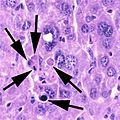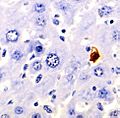Apoptosis facts for kids
Apoptosis is like a planned "self-destruct" button for cells. It's a natural and controlled way for cells to die when they are no longer needed, are damaged, or are old. This process is super important for our bodies to grow and stay healthy. For example, when a baby is developing in the womb, apoptosis helps to separate the fingers and toes, so they aren't just one big webbed hand or foot. This process happens a lot when we are young, especially until puberty. The number of cells dying through apoptosis needs to be balanced with the number of new cells being made.
Contents
Discovery of Apoptosis
The idea of cells dying in a controlled way was first talked about by Carl Vogt in 1842. But it wasn't until 1965 that John Foxton Ross Kerr really studied it closely. He used a special microscope called an electron microscope to see the tiny details inside cells. This helped him tell the difference between cells that died accidentally (called necrosis) and cells that died on purpose (apoptosis).
Later, in 1972, John Kerr teamed up with Professor Currie and Andrew Wyllie. They published a report in a science journal and used the word "apoptosis." This word comes from an old Greek word used by Hippocrates that means "bones falling off," like leaves falling from a tree.
How Apoptosis Happens
When a cell dies by apoptosis, it's a very neat and tidy process. It doesn't harm the cells around it. Here's what happens:
- Special proteins inside the cell, called enzymes, start to break down the cell's internal support structure, called the cytoskeleton.
- The cell's jelly-like filling, called cytoplasm, becomes very dense, and all the tiny parts inside the cell, called organelles, get packed together tightly.
- The outer skin of the cell, the cell membrane, starts to bubble outwards, forming small bumps called "blebs."
- The cell's DNA (which holds all its instructions) condenses, and the protective cover around it, the nuclear envelope, breaks apart. The DNA then breaks into small pieces.
- Finally, the whole cell breaks down into tiny packages called vesicles. Other special cells, called phagocytes, then come along and "eat" these packages, cleaning up the remains without causing any mess or inflammation.
Why Apoptosis is Important
Apoptosis is the normal end for many cells. Our bodies constantly make new cells, and sometimes there are too many in one area. When this happens, the DNA inside some of those cells tells them to start the apoptosis process, and they die safely. This is really important for our bodies to work correctly.
Imagine if liver cells kept multiplying but never died. The liver would get too big and stop working properly. Eventually, these extra liver cells could even take over other parts of the body. Apoptosis helps keep everything in balance. Special sacs inside cells, called lysosomes, also help with this process. When a cell is old or damaged, lysosomes can release their digestive enzymes, which then break down and "kill" the cell.
Apoptosis and Cancer
One of the biggest problems with cancer is that cancerous cells don't undergo apoptosis. This means they don't die when they're supposed to. Instead, they keep multiplying over and over again. This continuous growth can form a tumor and eventually stop the organ or the whole body from working correctly.
This happens because the DNA instructions for apoptosis in these cells have mutated (changed). Other parts of their DNA might also be changed, leading to very fast cell division of these unwanted cells. This uncontrolled growth is what we call a cancerous growth.
Images for kids
-
John Sulston won the Nobel Prize in Medicine in 2002 for his important research on apoptosis.
See also
 In Spanish: Apoptosis para niños
In Spanish: Apoptosis para niños








